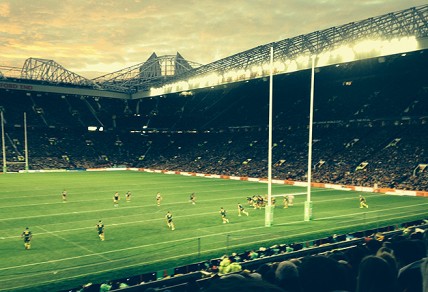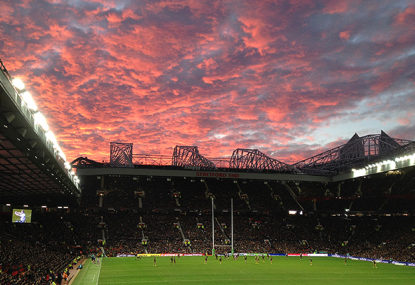A full 75,000 seat stadium can be a pretty lonely place sometimes, especially for two Australians sitting in a sea of Englishmen – Englishmen who had pledged their allegiance to the Kiwis.
And that was before we mentioned the cricket.
The Rugby League World Cup final at Old Trafford on the weekend was my first game of live rugby league for two and a half years, and flying into Manchester for the match from my new home in Berlin, I wasn’t sure what to expect.
At the pub before the game, there seemed to be a misunderstanding when I told them I was here to see the football.
I was greeted with “oh, the rog-beh”, and quickly realised that, unlike Australia, there is no debate as to what ‘football’ is in England.
At least I didn’t say ‘soccer’, which would have seen me bound for Botany Bay.
Instead I set off for the Theatre of Dreams, Old Trafford.
Old Trafford presents a different picture of itself, depending on where you view it from. Inside the stadium – the image beamed to billions of screens around the world once a week – the stadium is a modern architectural marvel, with bright lights, digital advertising boards and shining steel (albeit with only one moderately large video screen).
The playing pitch is raised, meaning no matter where you sit you can view the combatants in a theatre-like atmosphere.
The stands themselves are incredibly close to the action. You feel like you’re sitting on the players – just ask Brett Morris about how close the grandstands are.
Outside the stadium, and indeed all areas which television cameras don’t reach, the stadium is less modern splendour and more northern red brick charm. Toilets and catering facilities are somewhat antiquated, like a giant Brookvale Oval.
Everywhere you are reminded of the stadium’s history, or to be more accurate, the history of the stadium’s major tenant.
From German bombs to plane crashes, Manchester United and Old Trafford have a history that ‘franchise’ clubs and cookie-cutter stadiums back home in Australia could only dream of.
Getting into the stadium is relatively easy. Security is almost absent; there are zero bag checks and no queues despite the 75,000-odd in attendance.
In the minutes preceding the match, the stadium fills up quickly with the promise of the Haka. It turns out to be the biggest cheer the Kiwis get all night.
As for the game itself, it became apparent pretty quickly the Kiwis were the crowd favourites, despite the men in black being the main reason England were kept out of the final.
There was little love for the Australians. Aside from a failed streaker attempt in the second half, the crowd was kept mostly quiet, delighting in the few instances of Australian misfortune.
Australians love to knock English sports fans. They are sore losers and even worse winners.
But that said, they are incredibly loyal, particularly in the north.
There are few bandwagon jumpers among rugby league fans in England, and with good reason; the national side hasn’t won a trophy since the 1970s.
The man next to me had seen every one of England’s games in the Cup and had travelled to London last week for the semi-final.
As it became apparent the Kangaroos would achieve a crushing victory, talk moved on to England’s hopes in the coming years.
The talk had a decidedly ‘there’s always next year’ feel, a feeling this former North Sydney Bears fan knows too well.
The 2013 World Cup was England’s best chance for some meaningful silverware in 20 years, and the local fans knew it.
I reassuringly suggested the current Australian side was not unlike the Australian cricket team of 2006/2007; a group of superstars that just happened to be born at the same time, in the same country (and regretfully as a New South Wales fan, in the same state).
Cooper Cronk, Cameron Smith and Billy Slater, along with man of the match Johnathan Thurston, have been battle-hardened through eight consecutive series wins for the Maroons. They know each other’s games better than any spine in the salary cap era, and possibly in Australian rugby league history.
England’s time would come, we agreed.
The best players in the English team all ply their trade in the NRL, and while the stream of Super Leaguers going down under was bad for the Super League, we agreed it was good for the hopes of the national side.
A St Helens fan sitting in the row in front predicted England would win the next Four Nations series. Another predicted the next World Cup final would be between England and New Zealand. In Sydney.
In the end, Australia were too good. To win, New Zealand needed the rub of the green from the refs as well as a sizeable helping of luck. They had neither.
Does Stephen Kearney have the skill to coach at the highest level? With one World Cup and one Four Nations win, the past five years have been the most successful in New Zealand rugby league history and Kearney must receive credit for that.

New Zealand attack the Kangaroos’ line in the Rugby League World Cup final, 2013 at Old Trafford, Manchester. (Photo: Daniel Wighton).
People remember scorelines more than anything, so its likely the tournament will be remembered more for the Kangaroos’ dominance than other aspects such as the resurgence of the English, the fight of the developing nations and the belief among many fans before kickoff that the Kiwis might actually go back to back.
International rugby league is healthy. The current English side are the best in 20 years, and the depth and age of the Kiwis squad means we will see close contests in the years ahead.
France and Wales have young lists, the majority of which were born and raised there, and the performances of Fiji, the USA and Italy will have positive effects for the game domestically.
The 2013 edition is being called the ‘best ever’. The game has come along since the last World Cup in 2008, and with similar growth the 2017 edition should be even more successful.
As we were optimistically reminded by those around us as the siren sounded, “we’ll see you in four years”.






























































































